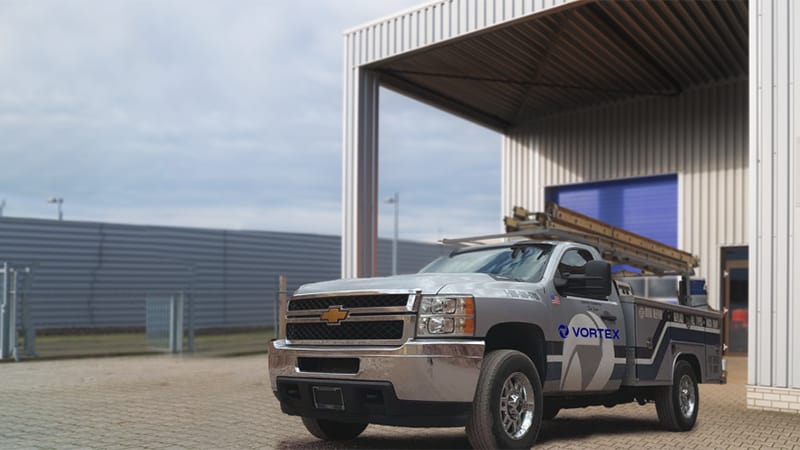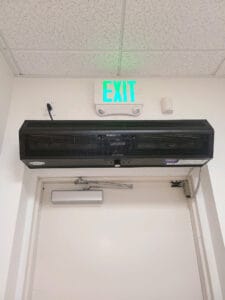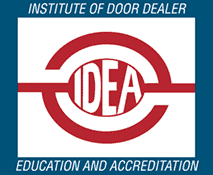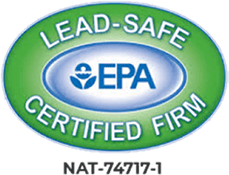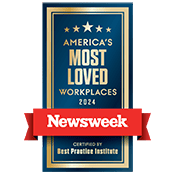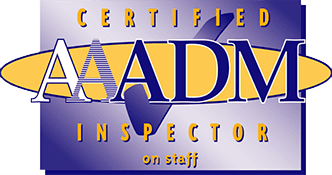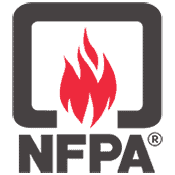Fire Door Requirements
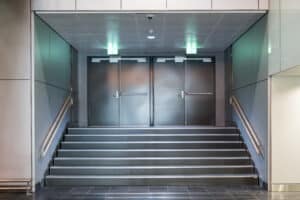
Fire doors are a critical component of building safety. They not only allow staff and visitors to evacuate during an emergency. They also slow the spread of smoke and flames, limiting structural damage. According to the National Fire Protection Association (NFPA) and the International Building Code (IBC), fire door assemblies must adhere to specific criteria for both life safety and the protection of property. Understanding fire door requirements is essential for business owners, not only to avoid regulatory fines, but to ensure occupants have a secure escape route during a life-threatening situation.
Basic Fire Door Requirements
The NFPA and IBC are not regulatory agencies. They do not have the power to enact or enforce fire codes. That power is reserved for state and municipal authorities. While some adopt NFPA or IBC regulations wholesale, others make changes that apply only to their local communities. Nonetheless, thanks to the influence of the NFPA and IBC, there are certain standards all fire doors are expected to follow.
Self-Closing
All fire doors need to be equipped with a closing device. Automatic closing hinders the spread of fire and prevents escape routes from becoming choked with hazardous fumes. Without it, there is no guarantee anyone will shut the door behind them as they exit the building.
Self-Latching
Positive latching devices ensure that a door remains securely closed even after someone passes through. Otherwise, fire pressure could force it open and compromise safety.
Fire Label
Fire door frames are required to have an embossed label listing its fire resistance rating – how long it can withstand open flames before it fails (typically 20, 45, 60, 90, or 180 minutes). Door labels confirm that the door has been tested and certified according to current safety standards. It also allows inspectors to verify that the door was installed in the correct location. (Certain areas require stronger doors. A door with a twenty minute fire-protection-rating can be installed in a private office, but not a stairwell, for example.) The label also provides valuable information about the door’s construction, including its model and manufacturer, in case it has to be replaced.
Door Hardware
A fire door assembly not only includes the door itself, but the equipment attached to it (frame, hinges, locks, latches, handles, door closers etc.). Each of these components needs to be rigorously tested in order to ensure they meet code requirements and can resist extreme heat without warping, melting, or cracking.
Fire-Rated Hinges
All fire doors are required to have steel-bearing hinges. In addition to their strength and durability, the bearings reduce friction, ensuring doors open and shut smoothly, even when subjected to heavy use. The hinges must also match the door rating. A door designed to last ninety minutes cannot function as a reliable smoke or fire barrier if its hinges only last thirty minutes.
No Obstructions
For the safety of building occupants, there can be nothing blocking the fire door. Any equipment or hardware that might interfere with its operation (e.g. chains, door stops, holdbacks, drapery) is strictly forbidden.
Astragals
Astragals are vertical strips of wood or metal attached to the edge of a door, to cover the gap between two swinging doors. Double fire doors that aren’t on an egress path require an overlapping astragal to function as a smoke barrier and prevent dangerous fumes from passing between rooms. Doors on an egress path may still require smoke seals to protect people as they exit the building.
Door Holders
Hold-open devices ensure your entryways are accessible to everyone, regardless of physical ability. They’re common in healthcare facilities, which often install fire doors along their main corridors. To ensure safety, these doors require a heat fusible link ‒ an automatic closer containing heat-sensitive metal that melts when heated to a certain temperature (165°F, for example). In the event of a fire, the metal link dissolves and shuts the door.
Open Strike Backs
A strike back is the metal plate that the door’s latch or bolt fits into. Typically, an open strike back is used whenever a fire door is equipped with an electromagnetic hold-open device. When the fire alarm activates, the magnet powers down, which releases the closer. Once it swings the door shut, the latch engages the strike back, securing it. All doors on an egress path are required to have an open strike back.
Glazing
Glazing is a glass panel installed in a fire door. It’s a safety feature that allows people to evaluate conditions on the other side without exposing themselves to danger. To ensure it can hold together during a fire, all glazing must be made of wire glass – glass embedded with wire mesh for added durability, at least a quarter-inch thick. Any door with glazing must also have a metal frame and glazing beads, strips of metal that contain the glass, with the same fire rating as the door itself.
Vents
Vents are allowed on fire doors, though they have to be handled carefully, since they’re a potential point of weakness. In some cases, fire vents can be installed for ventilation, air circulation, and temperature control, but only on doors 1.75 inches thick with a 45-90 minute fire rating. Combining them with glazing or fire exit hardware, such as a push bar, is forbidden. Stairwell doors are not allowed to have vents and all vents must be less than 24 x 24 inches.
Construction
Fire-rated doors are required to have a non-combustible surface, such as steel or fire-rated wood veneers. While steel is naturally fire-resistant, wooden doors are only fire-resistant when the wood is only a thin layer on the surface, covering the mineral core underneath – the real source of its strength.
Signage
Fire exits must be clearly marked at all times. Besides being placed prominently on or near the door, signs should also contain instructions on how to exit. For example, a door with a panic bar should include the words “PUSH TO EXIT.” Additional signage, such as “KEEP CLEAR” or “ALARM WILL SOUND” should be added when necessary.
Fire Door Inspections and Maintenance
Fire doors are designed to save lives, but can’t perform their role without regular inspections carried out by qualified personnel. Most fire doors need to be examined at least once a year. Doors in high-traffic areas may require more frequent inspections, however. Besides evaluating the door, inspectors test its hardware as well, including the frame, hinges, seals, and closing mechanisms, to ensure they’re intact and fully functional. If any component is compromised, it could compromise the entire door, jeopardizing the people and property it’s meant to protect.
Vortex technicians are certified by the NFPA. Their training enables them to catch signs of wear and tear, as well as improper installation, which could undermine the door’s integrity. By replacing and repairing faulty components, we not only safeguard your building and its occupants, but help you avoid legal penalties as well. Make sure your doors offer the strongest possible protection. Reach out and schedule your inspection today!

